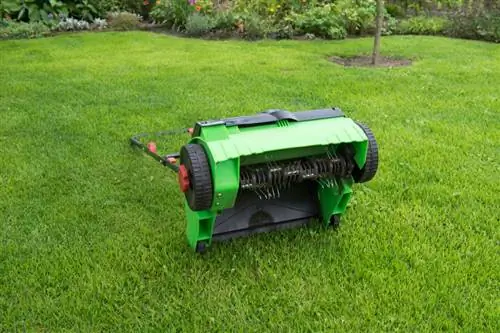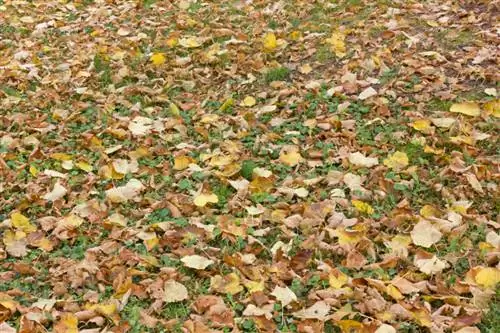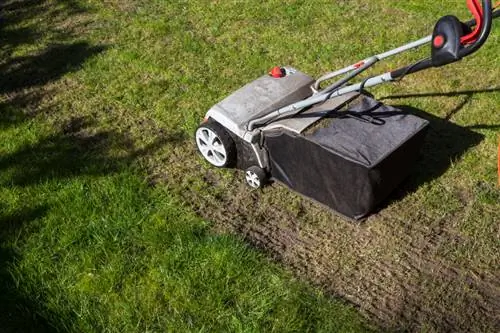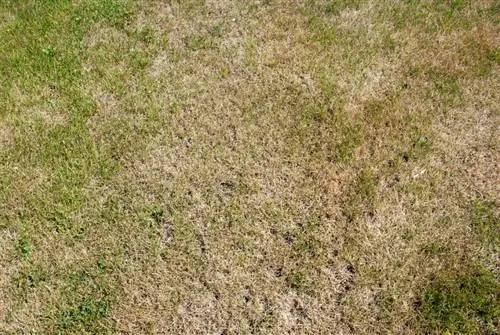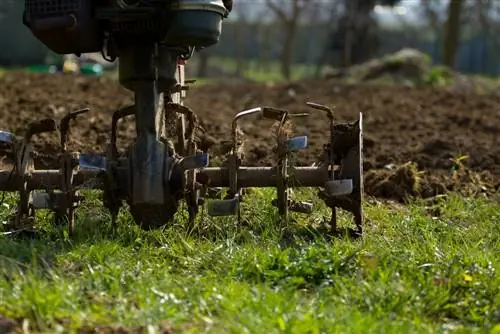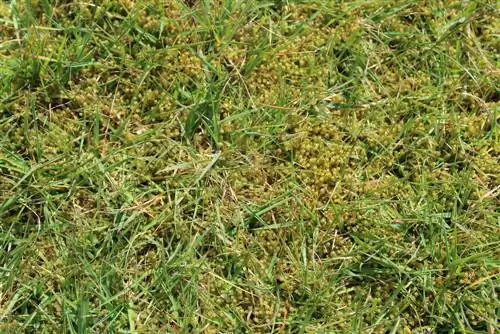- Author admin [email protected].
- Public 2023-12-16 16:46.
- Last modified 2025-06-01 06:02.
An intensively used lawn gradually becomes compacted, literally cutting off the air from the grass roots. You can find out here when aerating the lawn is recommended and which devices make the work easier.
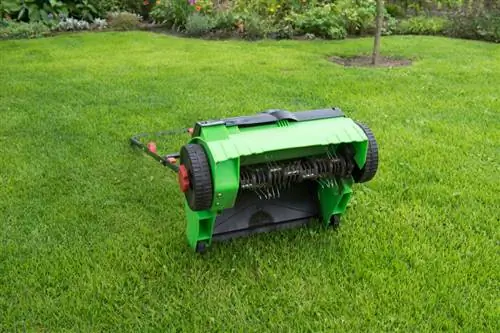
When and how should you aerate the lawn?
Aerating the lawn, also known as aerating, improves the oxygen supply and water drainage by loosening the turf. The best time to aerate is in the spring after the first mowing or in the fall. To do this, use machine-powered equipment or manual tools to create small holes in the ground.
What does aerating actually mean?
There is a widespread misconception among hobby gardeners that the terms aerating and scarifying refer to the same care measure. In fact, with a scarifier you comb moss and weeds from the surface of the lawn by using rotating motor rollers to score the turf 3-5 mm deep. If, on the other hand, you aerate the lawn, use the following method:
- The devices drill holes in the sod up to a depth of 100 mm using soil nails or hollow spoons
- Pulling holes evenly at a distance of 15-20 cm breaks up compactions
- The soil that has risen into the hollow spikes is collected and disposed of
If you ventilate your lawn in this way, harmful waterlogging is eliminated and does not form again. In addition, increased oxygen reaches the grass roots to activate growth there.
When does it make sense to aerate the lawn?
In winter, constant wetness and frosty temperatures affect the sensitive turf. Moss spreads, weeds push through and waterlogging forms. As if that wasn't enough, summer activities with children playing, paddling pools set up and exuberant barbecue parties also put pressure on the sod. You can find out when it's particularly good to ventilate your lawn here:
- Aerate the lawn in March/April after the first mow
- In September/October, ventilate the stressed grass area again
- Aerate heavily frequented green areas, such as golf courses or sports fields, every 6-8 weeks between March and October
Proper aeration undoubtedly involves additional work. If you want quantitative proof of the urgency of this measure, measure the degree of compaction with a penetrometer. These devices determine the penetration resistance in bar by piercing the ground. At the same time, a coloring reaction provides information about the result, from green (0-15 bar) for unnecessary to yellow (15-22, 5 bar) for recommended to red (22, 5 bar+) for urgent.
Step-by-step instructions for mechanical aeration
Aerating optimizes the oxygen supply and water drainage of the lawn by using special spikes to pierce the turf. This can be done very easily using machine-operated devices that can be rented from well-stocked hardware stores and rental shops. This is how you aerate the lawn in an exemplary manner:
- Mow the lawn 3-4 centimeters deep
- Before bleeding, equip the machine with the appropriate spoons to suit the soil quality
- Position the device so that you start along the edge of the lawn
- Press the lever to make the spikes move
- Push the aerator forward at appropriate speed
- If possible, do not step on the 'earth sausages' that have been pushed out again so that you can collect them at the end
The speed determines whether you drill the lawn deep enough. If the devices drive too fast, they will punch at too great a distance. If the speed is too low, the lawn will be too perforated.
Tip
Mechanical aerators are practical, but they do produce a lot of noise. Prudent hobby gardeners take into account the statutory rest periods when working on aerating the lawn, as are also required for operating the lawnmower. On weekdays from 9 a.m. to 1 p.m. and 3 p.m. to 5 p.m., the devices can drill the lawn as much as they can without worry.
How to aerate the lawn manually
Specialist retailers offer manually operated devices to aerate small lawns. Devices with a stable rail on which there is a handle with an ergonomic handle are particularly practical. The conical spines positioned at the bottom are hollow. These spoons push the earth upwards with each hole and collect it in a tray. This is how it works:
- The ground is freshly mown, frost-free, neither muddy nor dried out
- To ventilate, punch holes in the turf at a distance of 15 cm
- The end in the tub is disposed of in the compost
The following rule of thumb serves as an indication of when a lawn is effectively aerated: 200 holes per square meter sufficiently ventilate a compacted sod. The devices should be equipped with at least 2 spikes. With each additional spoon you aerate the lawn more intensively, you are of course forced to use more force each time you make a hole.-
Devices for every budget
In order to regularly aerate a large, intensively used grass area, it may be worth investing in a motor-driven aerator. From a financial perspective, however, purchasing manual devices is more likely to be considered for the lawn in the front garden. The following overview presents some common aerators as a decision-making aid:
| Aerator | PROFI Bauma BA-RL40 lawn aerator | Billy Goat aerator Honda engine AE 401 H | HUSQVARNA aerator TA 36 | Aerating roller | Rasenspecht aerator with collecting tray |
|---|---|---|---|---|---|
| Working width | 410mm | 450mm | 920mm | 900mm | 300mm |
| Working depth | 200mm | 70mm | 76mm | 45mm | 100mm |
| Engine power | 5, 5 HP | 2, 9 kW | Trailer | Muscle Strength | Muscle Strength |
| New Price | approx. 3,500 euros | approx. 4,200 euros | approx. 1,570 euros | approx. 1,070 euros | from 224 euros |
| Special feature | Solid and tube spikes | hardened hollow tines | for tractors from 16 HP | with 189 spikes | Spoons with 16-24 mm diameter |
Scarify mossy grass areas first - this is how it works
Hard-working hobby gardeners make their work unnecessarily difficult when they aerate a mossy lawn. In addition, after holes have been drilled, there is still not enough oxygen reaching the roots in a matted grass area. It therefore makes sense to scarify the greenery before venting. Follow these steps:
- The weather is mild, dry between 10 and 20 degrees Celsius
- The lawn is - exceptionally - mown as deep as possible
- Walk the lawn lengthwise and crosswise with the scarifier in two passes
- Sweep up and dispose of combed out weeds and moss
Without any further delay, you can then proceed to aerate the lawn. In the end, don't let the battered appearance put you off. With this intensive care program you have set the course for a velvety green, dense lawn carpet. The following lines convey what is still missing in terms of fine-tuning.
Sanden sets the perfect ending - this is how it works
Professional aerating results in a finish that is all about the holes created. By sweeping up a layer of sand after punching, the lawn receives effective drainage. How to do it right:
- Distribute half a bucket of sand per square meter
- Low-lime quartz sand with a grain size of 0/2 is ideal
- Sweep the sand evenly with a broom
If the grass growth appears to be particularly sparse after aeration, knowledgeable hobby gardeners combine sanding with reseeding. Thanks to the fine grains of sand, the lawn seeds spread easily and germinate quickly.
Topdressing - sanding at its best
English lawn artists have further developed sanding after aerating the lawn. With the goal of a durable green with a perfect look in mind, the experts created the top dressing. The sand is enriched with organic substances such as compost, horse manure or leaf mold. The result is a mixture that not only compensates for unevenness, but also improves the floor structure.
Tips & Tricks
During the summer, hobby gardeners often frown about how long a dry lawn should be watered. A sod sample reveals the water requirement. Simply cut out a 10 centimeter deep section of the lawn. If only the top 3 centimeters are dry, spray the lawn for 1 hour. A 5 centimeter thick dry layer requires a watering time of 1.5 hours.

